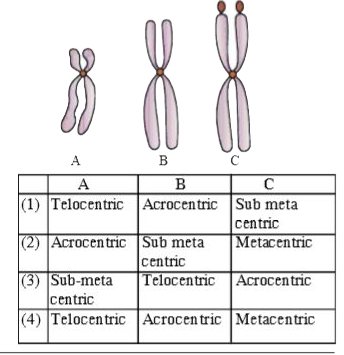During diakinesis chiasmata move from centromere towards the tip of the chromosomes. This type of movement of chiasmata is called
Synapsis
Bivalent formation
Terminalization
crossing over
The correct Answer is:C
Step-by-Step Solution:
1. Understanding Diakinesis: Diakinesis is the final stage of prophase I in meiosis, where homologous chromosomes condense and become visible. During this stage, chiasmata, which are points of genetic exchange between homologous chromosomes, are observed.
2. Identifying Chiasmata Movement: The question states that during diakinesis, chiasmata move from the centromere towards the tips of the chromosomes. This movement is significant as it indicates the separation process of homologous chromosomes.
3. Defining Chiasmata: Chiasmata are the points where two homologous chromosomes are attached to each other. They are crucial for the process of genetic recombination, where non-sister chromatids exchange genetic material.
4. Understanding the Movement: The movement of chiasmata from the centromere towards the tips of the chromosomes is a specific term in genetics. This process is characterized by the chiasmata slipping towards the ends of the bivalents (paired homologous chromosomes).
5. Identifying the Correct Term: The movement of chiasmata towards the ends of the chromosomes during diakinesis is referred to as "terminalization." This term specifically describes the process of chiasmata moving to the terminal ends of the chromosomes as they prepare for separation.
6. Eliminating Other Options: The other options provided (synapses, bivalent formation, crossover) do not accurately describe this specific movement. Synapses refer to the pairing of homologous chromosomes, bivalent formation refers to the structure formed by paired homologous chromosomes, and crossover refers to the exchange of genetic material at the chiasmata.
7. Conclusion: Therefore, the correct answer to the question is "terminalization."
---
Topper's Solved these Questions
- BOOK - AAKASH SERIESCHAPTER - CELL CYCLE AND CELL DIVISIONEXERCISE - Exercise-III18videos
CELL CYCLE AND CELL DIVISION
- BOOK - AAKASH SERIESCHAPTER - CELL CYCLE AND CELL DIVISIONEXERCISE - Exercise-III18videos
CELL CYCLE AND CELL DIVISION
- BOOK - AAKASH SERIESCHAPTER - BIOMOLECULESEXERCISE - EXERCISE - III (Previous AIPMT/NEET Questions) (Enzymes)11videos
BIOMOLECULES
- BOOK - AAKASH SERIESCHAPTER - ECOSYSTEMEXERCISE - EXERCISE-III (PREVIOUS AIPMT/NEET QUESTIONS)37videos
ECOSYSTEM
Similar Questions
Chromosomes move towards the pole during
View SolutionChiasmata are formed during
View SolutionChiasmata are formed during
View SolutionThe chromosomes having centromere at terminal end are called
View SolutionDuring protein synthesis, a ribosome moves from 5' to 3' end of mRNA to recognise all condons. This movement of ribosome is called
View SolutionSplitting of centromere and movement of daughter chromosomes towards opposite poles.
View SolutionA chromosome with centromere near the middle is called
View SolutionIdentify the type of chromosome with respect to centromere position :-
 View Solution
View SolutionName the type of chromosome which has a terminal centromere:-
View SolutionMovement of chromosomes during anaphase
View Solution

